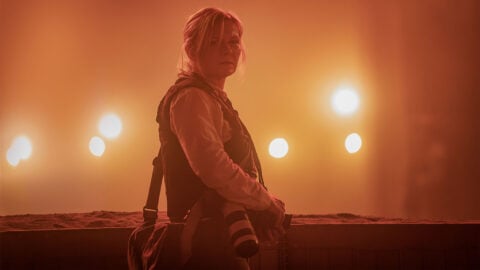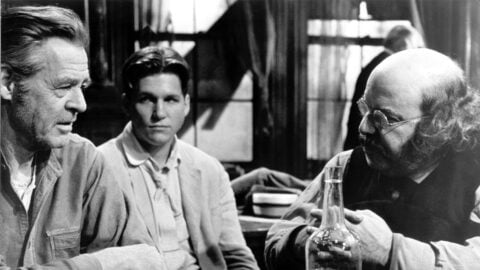Film of the Week: The Babadook

Strange, isn’t it, how in films about haunted houses, the TV always seems at some point to be tuned to a station that’s showing old black-and-white cartoons about the Big Bad Wolf; I guess the Primal Fear Channel never stops broadcasting. This cliché can be forgiven in Australian chiller The Babadook, not least because writer-director Jennifer Kent is nodding so wryly at the convention and, through it, at another film that made its own pointed use of the wolf trope, The Shining. Few horror films equal Kubrick’s—or now, indeed, Kent’s—for intelligently addressing terror’s source in childhood-related nature of terror, and for depicting the family as an inescapable place of terror rather than a shelter from it. Among bad-parenting frighteners, The Babadook earns a place of honor, steeped as it is in a history not just of horror cinema, but of Freudian interpretations of horror narrative in general (you can bet Kent is up on her Bettelheim). The Babadook, you might say, imagines how things might have been if Wendy Torrance, rather than her husband Jack, had been at the center of The Shining.
Kubrick echoes aside, Kent’s film hits an emotional nerve in its depiction of family trauma, specifically of a damaged relationship between a single mother and her young son. In Kent’s story, Amelia (Essie Davis) and six-year-old Samuel (Noah Wiseman) have plentiful cause to be troubled. As the opening sequence shows, through a (presumably recurring) nightmare of Amelia’s, her husband was killed in a violent car accident while rushing her to hospital to give birth. Samuel’s very existence is a token of his father’s death, his every birthday a dreadful reminder of loss; Amelia both treasures the boy, her only consolation in life, and bitterly resents his very existence. Dad, meanwhile, is never spoken of, all his belongings locked away in the basement of the family’s gloomy house; little wonder that the Repressed is announcing its imminent return, with nerve-jangling fanfares.
As the film starts, Amelia and Samuel are already having a rough time together: he’s hyperactive, desperate for her constant attention, and terrified of monsters; her own restless nights are further disturbed by the boy’s terrors. Samuel’s frenzied agitation and his dangerous behavior around other kids—he’s manically inventive, building a fearsome catapult to ward off threats—further isolates the pair. Add to this Amelia’s sexual frustration: a night in front of the TV, which seems to be targeting her with ads for sex, romance and chocolate, leads to a brief oasis of release with a vibrator before Samuel comes running in with his nightly heebie-jeebies.

Things could hardly be worse for the pair—until a pop-up book entitled Mister Babadook mysteriously appears in the house, as insomnia-inducing as the darkest imaginings of Edward Gorey and Maurice Sendak. The book, strikingly created by designer Alex Juhasz, depicts a top-hatted, black-cloaked, Freddy-clawed bogeyman: “If it’s in a word or in a look,” the accompanying verse goes, “You can’t get rid of the Babadook.”
Sure enough, once let into the house, the Babadook—like those marginally less baleful childhood visitors the Cat in the Hat and Gorey’s Doubtful Guest—is in no hurry to leave. But while it’s clear that this grim entity is staking claim to his hosts’ home and souls, Kent doesn’t actually show too much of the thing; it only manifests in physical form just short of the 50-minute mark, then appears sporadically in different guises, all chilling because so briefly glimpsed. It’s variously a thing scuttling across a ceiling, like a bat or a demonic umbrella; a lurking shadow in a neighbor’s house; an unexpected guest in a Georges Méliès film. What makes the Babadook so much more terrifying than the ghouls routinely conjured up in today’s mundane haunting tales of the Parasidious Conjuring school is Kent’s grasp of the uncertainty principle that makes for great horror. While a certain amount is depicted graphically enough—especially when Kent lets rip with the Poltergeist-like fireworks in the final act—overall The Babadook is a film that Val Lewton and Jacques Tourneur, screen horror’s high priests of the unseen, would approve of. Like David Robert Mitchell’s ingenious It Follows (to be released next year), it represents a welcome survival of the horror of suggestion.
Above all, we can’t be certain what’s going on, or what the monster is. Kent plays on the possibility that the book is not real in the first place; at least one of Amelia’s attempts to get rid of the thing is cleverly placed so that it could well be an episode she dreams. The Babadook—resembling a denizen of the child-scaring bedtime book to beat them all, Heinrich Hoffmann’s Struwwelpeter (1845)—appears to be an autonomous wraith bent on maximum harm. Perhaps the very people it terrorizes have created the thing: on one hand, the Babadook seems a concrete projection of Samuel’s terrors (pointedly, we’re told that he’s a boy who “speaks his mind”). Or maybe it’s an embodiment of the boy’s developing Id, a projection of omnipotence fantasies: Samuel too wears a top hat and cloak to practice his magic tricks, and the Babadook’s rasping voice (“Baba-dook-dook-dook!”) has definite overtones of The Shining’s Danny summoning forth his invisible familiar Tony.

On the other hand, the creature appears to embody Amelia’s repressed urge to avenge herself on Samuel: a writer who’s had to give up her work, she has possibly “written” the ghoul into existence (the Babadook is later identified with a gush of inky black liquid). And of course— phallically top-hatted like a Victorian paterfamilias or Mr. Hyde—the Babadook is also dead Dad, punishing the survivors for living on without him, and for the mother-son bond that excludes him.
The real horror story in The Babadook is an everyday one, familiar to every parent who’s ever known chronic sleep deprivation, or who feels their offspring are over-possessive, or threaten their adult autonomy. (Add to that the further horror of the guilt that affects a parent feeling such resentment.) The Babadook brilliantly keeps all these possibilities active, spinning from them a variety of horror-scenario variations, with the emphasis constantly shifting. Thus, Kent variously gives us mother and child terrified by interloper; mother threatened by child; child threatened by mother.
It’s in this last register that the film is most alarming (spoiler alert for this paragraph!): at times, Amelia’s and Samuel’s determination to protect each other becomes almost a mutual threat, a self-destructive folie à deux: at what point does over-protection of a child become deadly stifling? Eventually they go off the rails altogether—whether possessed by the Babadook, or just running out of psychic defenses—Amelia becomes the house’s resident monster. The Shining was scary enough, but the idea of the murderous ogre father was already familiar, going back in popular horror at least to 19th-century Gothic fiction and European fairy tale; what the once-nurturing mother becomes here is more perverse. In one sequence, the overtones of The Shining come to the fore as Amelia tries first to sweet talk, then to force herself into her terrified son’s locked room. But perhaps the film’s creepiest frisson is the subtlest, a shot in which Amelia is eerily transplanted into a TV news item, this film’s version of what happens to Jack in the final shot of Kubrick’s film.

There are many other echoes of screen horror here: clips of Maria Bava’s Black Sabbath; portents of domestic madness in the mode of Polanski’s Repulsion; a general sense of claustrophobia that’s more than a little reminiscent of The Exorcist; a use of grey paint and an overall color-leeched palette to rival The Sixth Sense; and as female-centric psychological horror, it also recalls the evocation of shadow-steeped nocturnal anxiety so chillingly staged in Robert Wise’s The Haunting (63). Note to self and others: this might be a good time to go back and look at another Australian woman director’s take on horror and childhood, Ann Turner’s superb Celia (88).
Undeniably brilliant as it is, The Babadook at moments feels a little overdone: that greyness too overwhelming, the telegraphic precision of Simon Njoo’s editing at times a little emphatic, the eerie angles of Radek Ladczuk’s photography at times overstressed (although there’s a wonderful way in which he and designer Alex Holmes give the house a horrid elasticity). And in the final stretch, when Kent unleashes her full arsenal of funhouse effects, there’s a distinct touch of “Now what?”
But ultimately all this—together with Frank Lipson’s abrasive sound design—adds up to a peculiar neurotic intensity that makes The Babadook feel all the more truthful in its ambivalent depiction of breakdown. The film’s very funny too: there’s a grotesque visit to a little girl’s “princess party” and a nicely stiff visit from some social workers.
What makes The Babadook so effective is that it’s as much character study as a chiller. Essie Davis’s Amelia is a superbly uncomfortable portrayal of pathological denial that seems to be sucking the blood and life out of her body: initially mumsy in a fragile way, Amelia looks increasingly waxy and pallid, which is why it comes so much as a shock when she musters a savage fury later on. And Noah Wiseman, wide-eyed and disheveled, shows a mischief and energy that only emphasizes Samuel’s vulnerability: it’s an astonishing, fearless performance, certainly one of the more startling child debuts of recent times (it’s hard to imagine that Wiseman wasn’t traumatized, but you can only imagine that Kent has been very ingenious about shooting him and Davis separately in certain scenes). At any rate, both actors make a very affecting, and sometimes tartly funny duo. It’s their rapport that makes the grim fairy-tale ending all the more poignant—a picture either of triumph over lethal adversity, or of two people imprisoned together in a new delusion that seems set to continue forever. But for some people, no doubt, that’s family.







